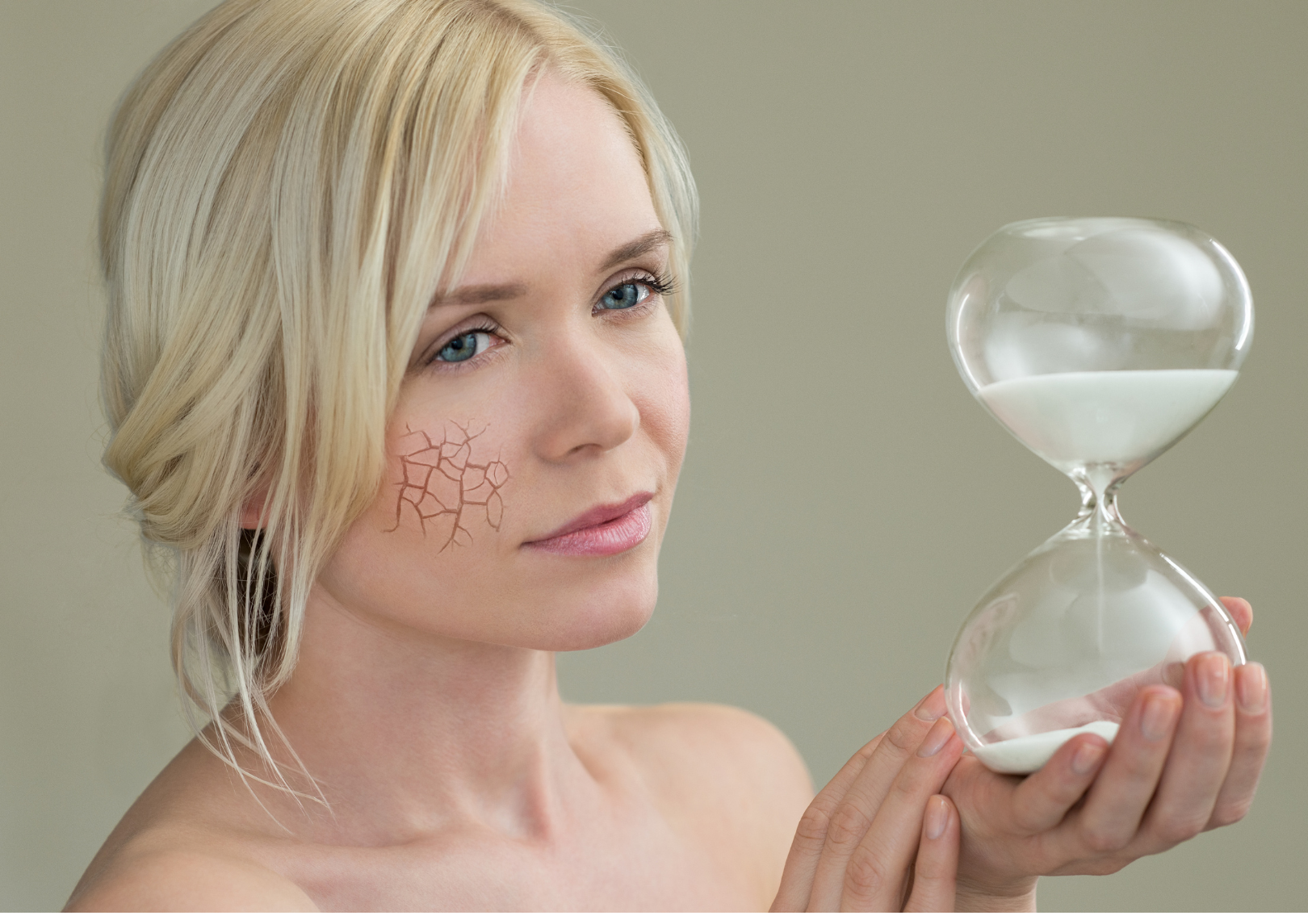NMN and NR Compared: Better Together or Choose One?
What if the secret to feeling younger and staying healthier lies within your cells?
Meet NAD+ (nicotinamide adenine dinucleotide) — a dynamic coenzyme that keeps your body running at its best. From energy production to repairing DNA and maintaining cellular health, NAD+ is a driving force behind a myriad biological processes that impact how you feel and function every day. But as we age, our NAD+ levels decline, leading to slower metabolism, fatigue, and other age-related challenges.
While our cellular fuel tanks deplete as we get older, scientists have identified two key compounds that may help refill it: nicotinamide mononucleotide (NMN) and nicotinamide riboside (NR). These precursor molecules act as building blocks for NAD+, offering a potential solution to age-related NAD+ decline. With mounting evidence supporting their efficacy, NMN and NR are rapidly becoming central figures in the field of longevity research
The scientific community has been working to determine which of these compounds might be more effective at boosting NAD+ levels – and the answer isn’t so straightforward. Each precursor has unique properties and cellular pathways, leading us to explore an intriguing possibility: could combining NMN and NR together offer advantages that neither compound can achieve alone?
In this article, you will learn:
- The fundamental differences between NMN and NR as NAD+ precursors, including their unique molecular structures and how they’re processed differently in your body’s cells
- How bioavailability impacts the effectiveness of these supplements, including the complex roles of transporters, enzymes, and gut bacteria in their absorption
- What clinical research reveals about both compounds’ effectiveness and safety profiles, with data from human trials showing their impacts on NAD+ levels and health outcomes
- How to make an informed choice between NMN, NR, or a combination approach based on your specific health goals, supported by cellular-level testing to optimize your supplementation strategy
NMN vs NR: Different Precursors, Different Pathways

NMN and NR are two of the most well-known NAD+ precursors, studied fairly extensively for their ability to increase NAD+ levels, support cellular energy, and promote long-term health. But while they share a common goal, their unique structures and metabolic pathways set them apart in how they influence your body’s health.
NMN is a larger molecule made up of a nicotinamide group attached to a ribose sugar and a phosphate group1. This makes it more complex than NR, which is simply nicotinamide linked to ribose, without the extra phosphate2.
This structural difference is critical in how each precursor is absorbed and utilized. For example, NMN can be directly absorbed by cells in some tissues, but in other tissues, it needs to be converted into NR before entering cells. NR, on the other hand, can be directly converted into NMN inside the cell.
The pathways that transform NMN and NR into NAD+ also follow different processes. NMN is primarily synthesized in the cell through a process called the salvage pathway3, where it’s created from nicotinamide with the help of an enzyme called NAMPT. Once inside the cell, NMN is converted to NAD+ through another enzyme, NMNAT.
In contrast, NR is phosphorylated by NR kinases (NRK1/NRK2) to form NMN,4 which then goes through the same process to become NAD+. Additionally, NR is absorbed by cells through specific transporters or can be metabolized in the gut to nicotinamide, which also contributes to NAD+ production.
Both NMN and NR are highly effective at increasing NAD+ levels, but their structural and metabolic differences can influence absorption efficiency and how quickly they act in the body. NMN’s ability to bypass certain steps may make it more effective in specific tissues, while NR’s smaller size allows for broader cellular uptake.
Choosing the right precursor depends on your health goals and how your body responds to each. Understanding these distinctions can help you tailor your approach to boosting NAD+, supporting cellular repair, and combating the effects of aging.
Key Takeaway: While both NMN and NR effectively boost NAD+ levels, their distinct molecular structures and metabolic pathways (with NMN being larger and containing an extra phosphate group compared to NR) lead to different absorption mechanisms and cellular utilization patterns in the body.
Bioavailability of NR and NMN

To truly benefit from NAD+ precursor supplementation, absorption is everything. So here’s the burning question: when it comes to NR versus NMN, which one does your body soak up like a sponge—and which one might just take an express trip to your bladder?
The bioavailability of NR and NMN is more complex than initially understood, and recent research has challenged some earlier assumptions about how these compounds are processed in the body.
Both NR and NMN undergo complex metabolic transformations before contributing to NAD+ synthesis. While earlier theories suggested NR might have superior absorption due to its smaller size5, current evidence paints a more nuanced picture. NR is likely absorbed intact and enters cells via equilibrative nucleoside transporters, where it’s converted to NMN.
Conversely, NMN may be directly transported into cells through a recently identified transporter (SLC12A8) in mice6, though its function in humans isn’t yet fully understood. Often, NMN is dephosphorylated to NR before cellular entry, then reconverted to NMN inside the cell7.
The metabolic pathway involves multiple steps influenced by various factors, including gut bacteria. The microbiome can deamidate NMN to nicotinic acid mononucleotide (NAMN), affecting its overall absorption and utilization8. While both compounds can be converted to nicotinamide (NAM), this isn’t the sole pathway. The process is more intricate than previously thought, involving a complex interplay of enzymes and transporters.
Clinical studies have demonstrated that both NR and NMN supplements can effectively increase NAD+ levels in human tissues, though their impact varies based on factors such as dosage, duration of use, and individual physiological differences.
Key Takeaway: While both NR and NMN can effectively boost NAD levels, their absorption and utilization involve complex, interconnected pathways influenced by multiple factors including transporters, enzymes, and gut bacteria, making a simple comparison of their bioavailability more nuanced than previously thought.
Is NMN or NR More Clinically Effective?

Both NMN and NR promise to boost your cellular energy and longevity, but which one delivers better results where it matters most – in clinical studies? Let’s examine the evidence.
Clinical Scorecard for NR
- Safety Profile in Human Trials: In a randomized, double-blind, placebo-controlled trial involving 1000 mg/day of NR supplementation for six weeks, participants reported no significant adverse events, indicating a favorable safety profile9 (Baur et al., 2019). Another study found that NR was well tolerated at doses up to 3000 mg/day without serious side effects.10
- NAD+ Elevation Capabilities: Research demonstrates that NR supplementation can significantly elevate NAD+ levels in human subjects. One study reported a ~60% increase in NAD+ concentrations after just six weeks of NR11 supplementation. Another trial showed that a single dose of NR increased NAD+ levels within hours,12 confirming its rapid bioavailability.
- Beneficial Outcomes: Clinical trials have shown that NR supplementation leads to improved metabolic health markers13, including enhanced insulin sensitivity and reduced blood pressure. Participants in one study exhibited improvements in physical performance, with a notable increase in walking distance during a six-minute walk test after NR supplementation. Another study indicated improvements in lipid profiles and overall cardiovascular health14 following NR intake.
Clinical Scorecard for NMN
- Safety Profile in Human Trials: NMN has demonstrated a strong safety profile in clinical trials. A study involving 250 mg/day of NMN over 12 weeks reported no significant adverse effects among participants15, indicating it is well tolerated. Another trial with doses up to 900 mg/day also confirmed the absence of serious side effects, further supporting its safety16.
- NAD+ Elevation Capabilities: NMN supplementation has been shown to effectively elevate NAD+ levels in humans. In one human clinical trial, participants taking NMN experienced significant increases in blood NAD+ concentrations at both day 30 and day 60 of supplementation17. Another study found that NMN doses as low as 300 mg/day could lead to substantial increases in NAD+ levels compared to placebo.18
- Beneficial Outcomes: Participants in NMN clinical trials have shown improvements in physical performance metrics, such as increased walking distance during exercise tests19. NMN has also been associated with better metabolic health indicators, including reduced arterial stiffness and improved cardiovascular function20.
In sum, both precursor molecules have proven their worth in the clinical arena – they just might suit different individuals based on specific health goals and preferences.
Choosing Between NMN and NR Supplements

With an understanding of the differences between NMN and NR, we now face a common question: which one should you choose as a dietary supplement?
While both molecules ultimately raise NAD levels, their distinct cellular uptake mechanisms and tissue preferences can lead to varying individual responses. Let’s explore the specific advantages of each approach, comparing NMN with NR, and why some advocate for using both together.
The Case for Nicotinamide Riboside
NR has established itself as a well-researched NAD+ precursor with an impressive track record of human clinical trials supporting its safety and efficacy. As a smaller molecule than NMN, NR may have advantages in terms of cellular uptake in certain tissues, particularly in the brain and nervous system. Its metabolism is well-understood, with specific transporters identified in various cell types, and it has demonstrated promising results in studies focused on cognitive function, muscle performance, and metabolic health.
For those seeking a thoroughly studied option with a clear safety profile and established manufacturing processes, NR represents a compelling choice.
The Case for NMN Supplements
NMN supplements offer potential advantages in certain cellular contexts, particularly in tissues that express specific NMN transporters like the Slc12a8 transporter found in the small intestine. Some researchers believe that because NMN is just one step away from becoming NAD+ (whereas NR requires an additional conversion step), it may provide more direct benefits in certain tissues.
Recent human studies have shown promising results for NMN in areas such as muscle strength, endurance, and cardiovascular health, making it an attractive option for those focused on physical performance and metabolic enhancement.
The Case for Taking Both Together
A combination approach incorporating both NMN and NR may offer the most comprehensive strategy. Different tissues and cells throughout the body may preferentially utilize one precursor over the other, and using both ensures that you’re providing your body with multiple pathways to increase NAD levels.
While no direct comparative studies exist between the two molecules, the complementary nature of their uptake mechanisms and tissue distribution patterns suggests that a dual approach could maximize the potential benefits across various body systems. This strategy, while potentially more costly, provides a more complete approach that accounts for the body’s complex and varied cellular preferences.
For those interested in tapping into the combined power of multiple NAD precursors, our clinically validated Vitality ↑® NAD+ Booster offers a convenient all-in-one solution for improved levels of NAD. This scientifically formulated blend combines precisely dosed NMN and Nicotinamide with bioactive D-Ribose and Creatine to maximize NAD+ production, helping reinvigorate cellular energy production, support healthy aging processes, and optimizing overall vitality.
Is NR Better Than NMN for NAD+?

The debate over whether NR or NMN is the better choice for boosting NAD+ levels doesn’t have a clear-cut answer, and that’s okay. Both compounds offer unique benefits, each helping to raise NAD+ levels and improve metabolic health and cellular function. Rather than comparing them directly, it might be more useful to see them as complementary allies, each playing a part in supporting overall health.
Ultimately, whether you choose NR, NMN, or both, each offers great potential for improving your health and longevity. When used thoughtfully, they can complement each other, enhancing their benefits and helping you reach your wellness goals.
Before You Decide, Why Not Test Your NAD+?

Transform your NAD+ optimization journey with our groundbreaking Intracellular NAD Test. Our test is the only solution that measures NAD+ levels directly within your cells – where it matters most. This insight eliminates the guesswork and reveals your true NAD+ status with unprecedented accuracy.
Your test results provide a precise blueprint for supplementation: If your cellular levels are lower than optimal, NR or combinations might be your ideal starting point for efficiently raising NAD+. For those with healthy baseline levels, NMN could be the perfect choice to maintain and enhance your cellular vitality.
The unmatched precision of our Intracellular NAD Test becomes even more valuable over time. When you establish your baseline and monitor changes, you can fine-tune your supplement routine based on real, cellular-level data – a capability unavailable anywhere else. This pioneering approach ensures your investment in NAD+ supplements delivers targeted, measurable results for your health and longevity goals.
Referenced Sources:
- https://pmc.ncbi.nlm.nih.gov/articles/PMC6359187/ ↩︎
- https://pmc.ncbi.nlm.nih.gov/articles/PMC10459282/ ↩︎
- https://pmc.ncbi.nlm.nih.gov/articles/PMC7963035/ ↩︎
- https://pmc.ncbi.nlm.nih.gov/articles/PMC6145238/ ↩︎
- https://pmc.ncbi.nlm.nih.gov/articles/PMC7352172/ ↩︎
- https://www.nature.com/articles/s42255-018-0009-4 ↩︎
- https://pmc.ncbi.nlm.nih.gov/articles/PMC10917541/ ↩︎
- https://www.biorxiv.org/content/10.1101/2020.09.10.289561v1.full ↩︎
- https://www.cell.com/cell-metabolism/fulltext/S1550-4131(19)00320-4 ↩︎
- https://www.nature.com/articles/s41467-023-43514-6 ↩︎
- https://pmc.ncbi.nlm.nih.gov/articles/PMC10692436/ ↩︎
- https://pmc.ncbi.nlm.nih.gov/articles/PMC9495723/ ↩︎
- https://pmc.ncbi.nlm.nih.gov/articles/PMC7398770/ ↩︎
- https://www.sciencedirect.com/science/article/pii/S0002916522008103 ↩︎
- https://pmc.ncbi.nlm.nih.gov/articles/PMC9158788/ ↩︎
- https://www.cell.com/cell-metabolism/fulltext/S1550-4131(16)00399-X ↩︎
- https://link.springer.com/article/10.1007/s11357-022-00449-x ↩︎
- https://www.nature.com/articles/s41598-021-01360-1 ↩︎
- https://pmc.ncbi.nlm.nih.gov/articles/PMC8265078/ ↩︎
- https://pmc.ncbi.nlm.nih.gov/articles/PMC9170600/#: ↩︎





























































